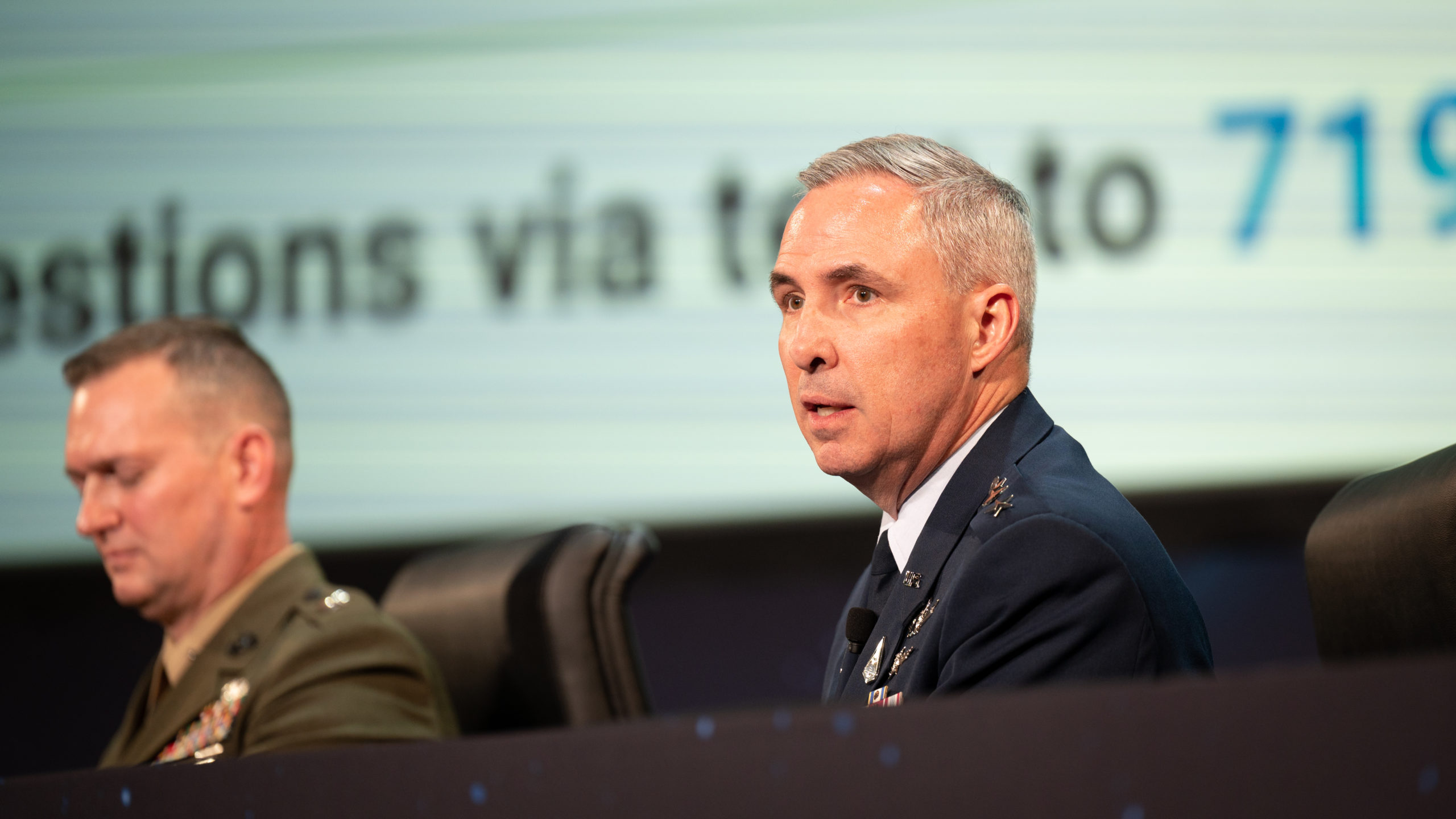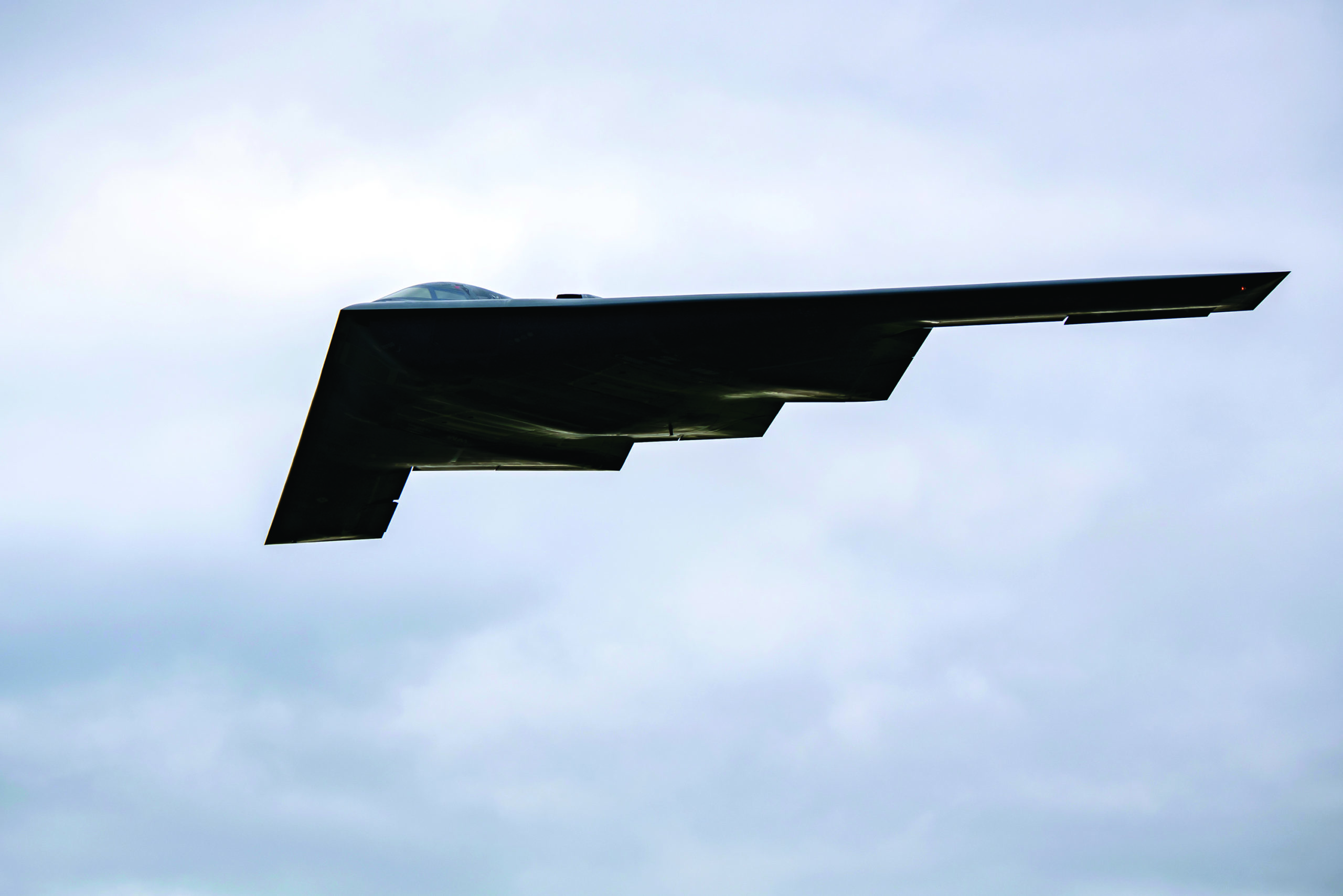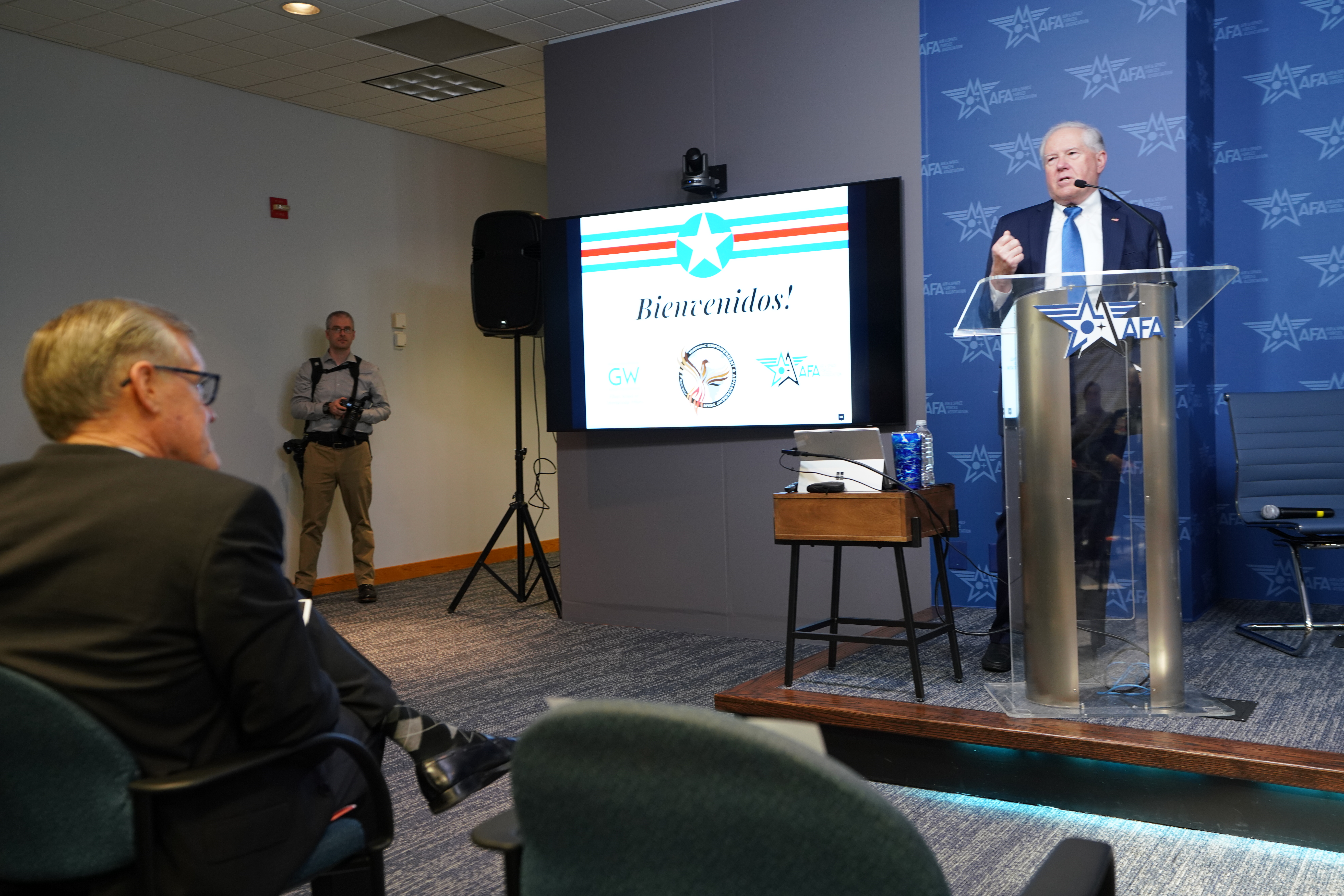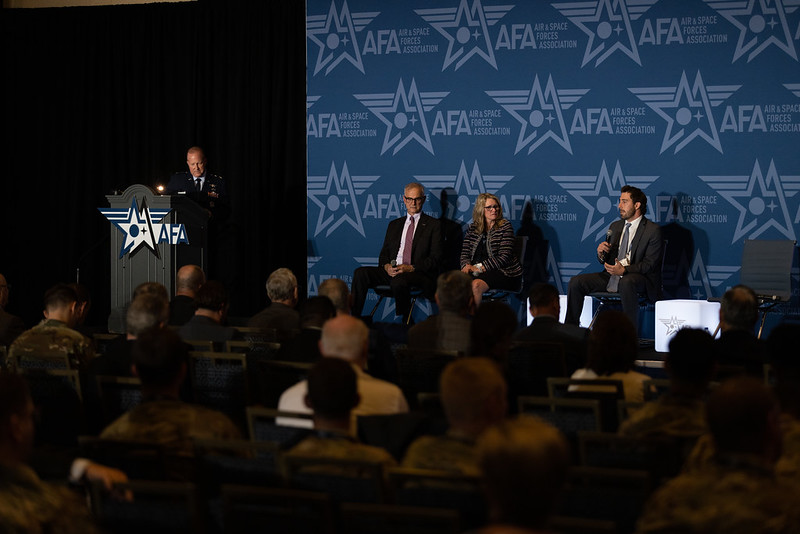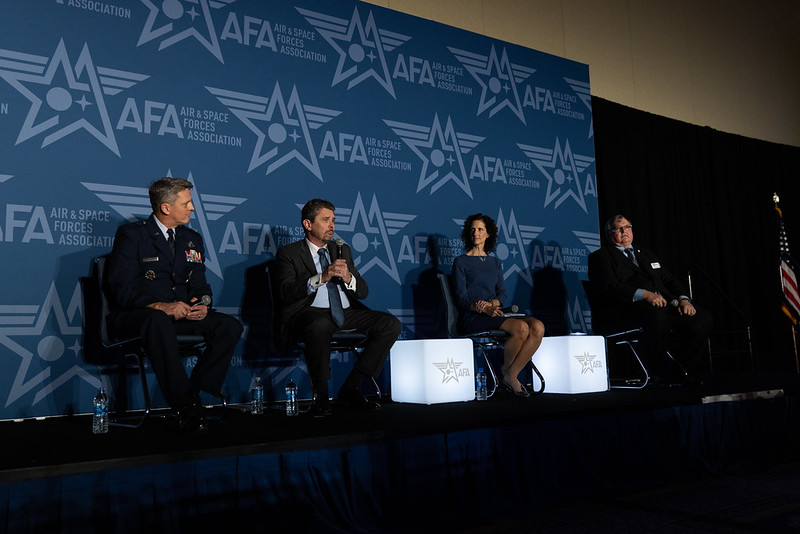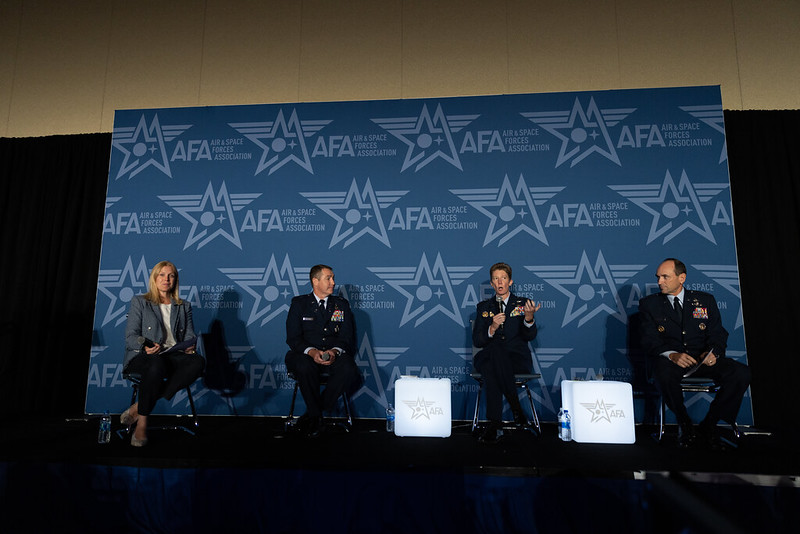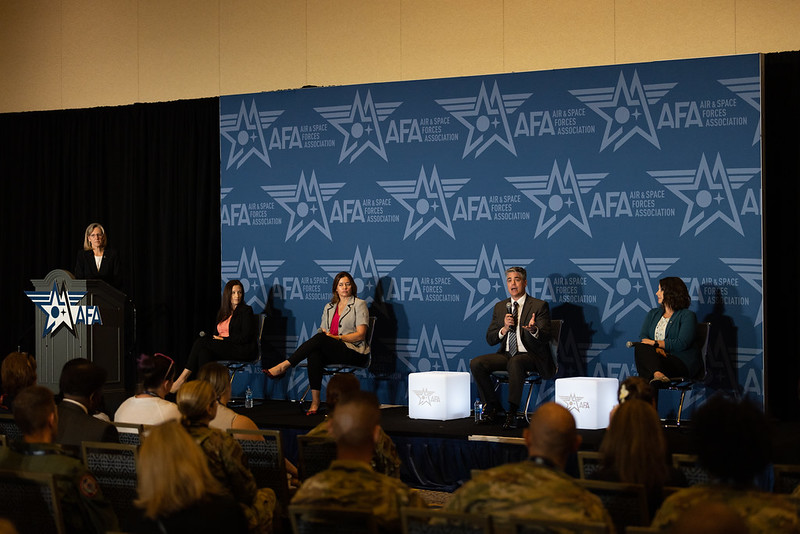Brig. Gen. Jeffery D. Valenzia, the Department of the Air Force’s Advanced Battle Management System cross-functional team lead, moderated a discussion on “Connectivity and JADC2” with Ron Fehlen of L3Harris, Lanny Merkel of Collins Aerospace, and Joe Sublousky of SAIC, Sept. 21, 2022, at AFA’s Air, Space & Cyber Conference. Watch the video or read the transcript below. This transcript is made possible by the sponsorship of JobsOhio.
If your firewall blocks YouTube, try this link instead.
Brig. Gen. Jeffrey D. Valenzia:
Good morning. My name is Jeff Valenzia. I am co-lead of the Advance Battle Management System Cross Functional Team in the Department of the Air Force. My counterpart, Major General John Olson, some of you heard him speak on Monday. And we’re here to talk about what else, besides JADC2 and ABMS. And what I have up on stage with me today is some esteemed and committed partners and thought leaders in the topic of ABMS and JADC2. So if we can go down and, Lanny, we’ll start with you. Introduce yourself.
Lanny Merkel:
Good morning, everyone. Lanny Merkel, the director of JADC2 capabilities for Mission Systems in Collins Aerospace. I appreciate the opportunity to be back on this panel. We had a discussion on JADC2 back in March. I think there’s been a lot of things that have changed since we last talked about this subject, so I’m really excited to dig into it a little bit more on what’s been accomplished and what’s out in front of us. By background, I’m the only one, I think, on this panel that hasn’t served. I’m the engineer on this panel, right? And I make a point of that to say we need all types of people involved in this, trying to solve this problem. People with operational experience, people with engineering and modeling, technical expertise, to go try and solve this problem. So I’m really excited about having this diverse set of thoughts to try and explore this a little bit more.
In my current role, I do have a couple of different objectives that we’re trying to achieve. First is trying to go out and demonstrate capabilities that exist today, that support enabling JADC2 through large service exercises. And I would say the second major objective is our operations analysis and mission engineering activities. So when I heard the discussion yesterday about the model associated with ABMS, the engineer in me got really excited about how we can engage with that and develop it together. And I think we’ll dive into that a little bit more as we go forward. So just appreciate General Valenzia and AFA having us together here to have this dialogue.
Ron Fehlen:
Good morning, Ron Fehlen, I’m the vice president and general manager for the Air Force and the Space Force business in the communication segment of L3Harris. The mic?
Brig. Gen. Jeffrey D. Valenzia:
Yeah, I don’t think your mic is working.
Ron Fehlen:
That better? It’s amazing what having connectivity will do to a conversation.
Lanny Merkel:
But that was the most insightful thing you had said all day.
Ron Fehlen:
Thank you, I appreciate that. Ron Fehlen, I’m the vice president and general manager for the Air Force and the Space Force business in the communications segment of L3Harris. By background, I’m an engineer as well so I certainly value that part and appreciate Lanny being up here to participate. But from an operational perspective, after 28 years in the Air Force, 10 of that was in an E-3 in AWACS. Flying in the nineties, the no-fly zones for those of you that remember that, and being able to monitor that and counter drug ops. And so being on the mission crew as a technician, and being able to lean over the shoulders and watch the air battle managers, air surveillance officers, as well as the senior directors and weapons directors, and then that integrated by a mission crew commander driving that entire mission, then see how that integrates into the battle space in a fairly simple mission. Not really a high end, but a simple and just go in and watch and see who decides to take off that day if they dare, as well as paint us and then take action.
And even seeing in that role when it’s really about deconfliction, and we’re moving in the ABMS realm to more integration of the joint forces, really that’s the perspective, when I bring not only the engineering hat, but at least that operational perspective of putting it in place. At L3Harris, we provide, as we look at the sense, make sense and act, we’re a part of each element of that. Bringing sensors in all domains, whether that be in space, maritime, ground, or airborne, to be able to provide the data that’ll be critical to our battle managers to do their job. And then of course the data fusion that we all hear about in the news, of course we do it as well, fusing that data to make sure that we understand it and that we have confidence in that data as we’re about to act on it.
And then being a part of the effector side as well, if you will, from being able to take action. So from my role though, I look at it, we get to work the underlying infrastructure. Just like this mic not being turned on in the beginning, we’re the ones that make sure they’re secured, resilient, assured networking communications. So there aren’t those data dropouts. So it arrives when it needs to arrive, and to the right people to make those assessments. So really excited to be here and have this conversation this morning. Thank you.
Joe Sublousky:
I’m learning from you. So Joe Sublousky, I’m the vice president of JADC2 for SAIC. And I feel like I’m in the hot seat here because if you were in Orlando, the two to my right were there and the third person is not here. So I’m in a hot seat here. Sir, I’ll try to do the best I possibly can. SAIC, as far as JADC2 is concerned, we are excited to be a part of AFA, excited to be a part of the panel. From the perspective of what I do, I try to associate a strategy around capabilities to support the JADC2 architecture, specifically in ABMS we’re going to discuss today. Looking forward to that.
I would tell you that SAIC, as part of the ABMS digital infrastructure consortium, we’re well engaged and well involved in that with a number of companies to try and figure out what this next step’s going to be for ABMS, in defining what the requirements for digital infrastructure are. And it’s absolutely critical to do that before we get started with actually buying products. I have been in that realm before. So I did a stint in the Air Force, a little bit of time in the Air Force, and so my background is I’ve been in a ACOM squadron, I’ve supported AOCs in PakAf, I’ve supported combat communicators in Europe at the EDGE and I did influence operations et cetera for NORTHCOM and then finished up my career as the AFCENT A6 down in Shaw for 39 months. So I’ve lived the as is that we actually have today.
I’m looking forward to getting after the 2B. The other part of SAIC is you might be aware that we’re taking over the sustainment and the modernization of the operation center, which is the C2 construct of what we’re trying to build for the future. So with all of that said, my background is atypical comm. I’ve never been assigned to a comm squadron, I’ve always worked for operators and a lot of the folks here at AFA I got to talk to and I’ve learned a lot and looking forward to having a conversation around where we’re going. Thank you.
Brig. Gen. Jeffrey D. Valenzia:
Now thank you. 1957, the PTOMIC Division. 1982 Air Land battle. 2010 Air Sea Battle. Today, JADC2. Each of those have sought to get after the exact same war fighting principle of combined arms. Only each of those has approached the problem from a different angle. In 1957, it was an organizational problem. Air Land battle, a doctrinal problem. Air Sea battle, it was weapons and platforms. Today, data. But at the core in each one of those imperatives, is war fighting in front of the widget. This has got to be about operational success out on the battlefield against our pacing adversary. And we talked about this two years ago and we said, “Look, this problem’s hard, but it’s not impossible.” Last year we talked about we are not writing the man out of command and control. And today what we’re going to talk to you about is the fact is we need a disciplined, describable, and defensible way that we’re going to build combined arms through in a data-centric world.
So yesterday we had an opportunity to introduce to industry a model-based systems engineering description about a management that was created by Colonel John [Zahl 00:08:32] and a team of experts out of the department of the Air Force who sat down and had done the hard work to describe with precision to an engineering level of detail what it means for an institution to make a decision in combat and how an individual, their intuition and their experience is going to be a part of that execution. And so what I’d like to do is like to turn to our panel and talk a little bit about maybe some of the reflections from industry’s perspective now that they’ve gotten to see behind the curtain, they’ve seen the logic that goes into a model based systems engineering description of what oftentimes is a very hotly debated understanding of command and control and how it’s going to translate into where industry is going to be able to contribute to the modernization of warfare. Lanny, let’s start with you.
Lanny Merkel:
When you look at model based systems engineering, I think the real value we see from an industry perspective is that precision that you referenced, right? We’ve all experienced reading requirements documents and there’s some implications associated with them, but you don’t really get the context, you don’t get the precision, you don’t understand the intricacies and how the activities are really related like you do when you have a model based systems engineering model of what’s trying to be achieved. And I think from an industry perspective, we all have different capabilities that we can bring to JADC2 and it helps us understand from a large complex problem perspective, how are we going to break down that problem?
I think he talked about 13 different items that would be making up the sense, make sense, act decision cycle. And so then we can see that decomposition so then I can have more direct line of sight to capabilities that I have that can support individual pieces and how those capabilities need to be developed and integrated in order to support the larger enterprise. And it gives us a framework to dialogue, right? Dialogue back to the government and the Air Force on areas we see that are really beneficial in the model and maybe areas that we see that have some limitations. And then we can also dialogue with my colleagues here in industry on different capability sets that we have and how we can not only implement them but integrate them together in a much more structured fashion.
Ron Fehlen:
So I’ll jump in. There’s nobody in this room that’s ever worked on a program who doesn’t see the value of strong system engineering. The idea that you have to walk through a discipline process in order to attack any size challenge frankly is absolutely critical Doing it in, I’ll say contemporary tools for model based system engineering, critical. Absolutely. I think one of the other things, and you said it last year, I think in this very room about enabling a connected conversation among the partners associated with making this a success. And that model in particular allows you to go from conceptual sort of blank sheets of paper down to start having that very disciplined conversation and start to really understand what are the ground rules that we’re going to use behind that model. What are the assumptions that we’re making within that model? And what are the boundaries associated not only with the model and totality but the different elements and that functional architecture that you guys have been working on.
So from that perspective, it enables that connected conversation. And it’s really interesting in about four or five years ago we tried to do some analysis on space command and control at the time working with General Raymond on a jumpstart effort. And as we went through that process using a multi-domain OV and CONOPS to try to ferret out how are we going to communicate across the domains? When we went back with a team later and said, okay, what are the biggest three challenges? What’s going to stop us from doing this? And I was actually quite surprised, their number one challenge is language, lexicon. Using the same term but meaning something else. And so as you’ve laid down this model, it is going to enable that conversation. Are we talking about the same thing? Are we in the same context from how functionally we’re going to do this? And then the next piece of the puzzle, of course, this is what I’ll say is a necessary ingredient that’s going to be a recipe for making JADC2.
The other necessary ingredient obviously is the digital and ABMS digital infrastructure consortium. We’re a part of that. It’s great to see that picking up steam as we lay down the infrastructure that’s going to have to reside underneath that and to provide connectivity, security, and assurety of all that data management moving back and forth because all the algorithms we put on top and all the decisions we make, if we don’t have access to that data, if we don’t have assurety of that management and then assurety of that data being there, then it limits our ability to actually employ within a Jordan environment.
And then I’ll say lastly, a real key there is frankly, once you have that context, throw it in the operational blender. Bounce it against the operational CONOPS and see where it starts to break, where it’s not going to work out. As I mentioned previously at my time in AWACS and watching that, I watched times where what appeared to be a very simple mission, right? Take out from Incirlik, fly towards the northern fly zone. F-15s are going to launch, sweep the box for us, we’re going to insert, they’ll stay on cap, we’ll stay in our of course on our race track and we’ll watch the fly zone. We’ll take action as appropriate.
Even in the deployment of resources, making sure that they’re there at the right time, two F-15s kinks on the Incirlik runway, they’re delayed by two hours and we’re hanging on orbit back from the fight. Back from the mission we’ve been sent to do simply because the resources weren’t there. So I look at it and say we’ve got to have not just the resource, we got to understand them, how we’re going to make the decisions, but we absolutely have to have that infrastructure laying flat in order to make sure that the data is there for the battle managers.
Joe Sublousky:
So I’ll tell you from my perspective, absolutely agree with those comments. What I would tell you is I spent my career integrating and I integrated because I didn’t model. And I think that starting out with this modeling based approach, SAIC has been doing this for a long time at MDA and what I see us doing now for battle management is absolutely critical. You’ve got to start out with a foundation. The lexicons, the actual understandings, I used to call it the bubbles above our head need to match. If my bubble doesn’t look like your bubble, we’re starting from an area that we shouldn’t start from. And when we do that, we turn ourselves into integrators. And I was talking to General Smith yesterday and what I said to him was, I said, “Hey sir, the as is? I built it for you. You asked for more monitors, I gave them to you. You asked for more data, I gave them to you. I built them so high you couldn’t see each other and now you’re asking me to remove them. We can do that.”
But I was integrating, I was taking capabilities, trying to put them into war fighter’s hands and I was trying to overwhelm them with my prowess on how I could bring data to them. Not looking at the types of data that they needed. A tech sergeant taught me this a long time ago and we were doing an exercise and it was back in the day and the whole thing was around SCUD hunting and the tech sergeant that was an intel enlisted member, he knew the notation for a SCUD and he said, “Hey sir, if you can find that, I can tell you the next set of data is going to be what we should be avoiding and what we should be sending.”
And I said, “That’s easy, I can pull that off the line pretty quickly.” So we started doing that and then he said, “You know, if we take that and we can actually just send it to the printer next to the chief combat ops, he can actually get the alert out a lot faster.” So with that little bit of knowledge and that little bit of understanding between the two of us, we were able to basically usurp the process that was delaying our activities to get the word to the folks down range to save their lives. Although it was in an exercise, it proved to me that the value is when our bubbles about our head match, we can actually make a difference. So I think that’s important aspect of starting out with MBSC.
I think the second aspect is the iteration. It’s the iteration between the consortium, the FFRDCs, industry, government, all of the people in that. It’s the iterations at which we go back and forth and share and keep improving what we each think we know so that it becomes a standard that we can build from.
Brig. Gen. Jeffrey D. Valenzia:
Yeah, Joe, you bring up a good point. MBSC wasn’t invented for JADC2. It’s not invented on behalf of ABMS, but in fact it’s a business best practice. It’s used in many develop of many complex systems of systems types of capabilities. What we’ve done is an adaptation and taken it and applied it to something that has been ill defined for a long time, but it also gives us the advantage. Now we can start putting measures of performance, understand vulnerabilities, understand measures of effectiveness.
For example, how long does it take to decide? How many targets can you process till the system breaks? What’s the variance when we have about a manager who’s the ace of the base beeps all or about a manager who maybe has just graduated training and we expect both of them to operate in the same complex environment as a single entity. Those are some of the things we as the war fighting element really value. And I want to go back to Ron, something you said because you started teasing out, there’s some things industry looks at when you give him a model that’s disciplined by model based systems engineering that sometimes the war fighters don’t necessarily give a strong consideration. I’d like to revisit a little bit as you talked about the management of data and what’s going on maybe behind the scenes that could impact the operational outcome.
Ron Fehlen:
So let’s use it in an anecdote that most of us, I dare say all of us are familiar from a data management perspective. We do it every day in our lives. For those of you who know what a Rand McNally map is, probably the least innovative thing in our lives, challenged every family vacation. For those of you, there’s probably some in this room who don’t even know what I’m talking about, which is good. And then imagine your drive today, you transit the battle of DC traffic getting from here even out to Ashburn or something of that nature. And suddenly you realize the value of having something underneath collecting and managing all that data from all different sources and providing that to you. Now I suspect if you’re like me, you didn’t have a lot of confidence in Google Maps or whatever you use the first time you used it and you thought there’s no way I’m going to use this route.
And over time we have built confidence in the tools that we use on an everyday basis in our daily lives because we’ve grown confident in the data. We have a general idea of the sources. It’s fused together in a way that makes sense to us. It’s presented in an aspect that we can actually, in some cases while on the fly, in traffic sort of figure out do I really want to trust the machine what it’s telling me? Or maybe I do want to take an alternate route because I know something a little bit better. And we watch it sort of learn in some cases if you pay attention over a long period of time, you start to see it learn a little bit of different behaviors. I think from a data management perspective, one thing that from an L3Harris perspective, we bring some program or record from a NCCT standpoint where we’re fusing together targeting data, fusing together data for targeting.
And it really looks a lot like what I see in my daily life to give those options. So the data management piece is really important, not just from it showing up at the classification levels of it as well and then how you work it into the system from a presentation standpoint. And I think going back to the model based system engineering, that being able to create that HMI again, that’s an effective HMI for our battle managers.
Again, an expertise that of course we have. But I think in the end I look at it and say, can they be confident in the data? Not that it’s just going to arrive because that’s the critical first step. If the data doesn’t arrive, it doesn’t matter. But the second step of how do we train with those systems over the course of time to make adjustments as well as gain confidence in the algorithms and the assessments that are going on. And then I think frankly to not just jump off but actually do where you can buy and actually pull that forward and incrementally update it to gain that confidence and training, I think it’ll be a critical, from an understanding, I can trust what I’m seeing so that I can take actions in an operational environment.
Brig. Gen. Jeffrey D. Valenzia:
I’m going to go back to something Joe, you really brought up an interesting point and you said, hey, I get the as is and in fact I built the as is. And what you’re really getting at is sometimes when we start to really pick apart with a high degree of detail our current as is, we find that maybe it isn’t all that needs to be for the type of fight we’re going after and we start to turn over some current paradigms.
From an operational perspective some of our analysis has showed us that when you take the current way we array authorities within a combat scenario, they work extraordinarily well for what we have been doing at the volume that we have to process. But then when we stand it up against a pacing threat and our secretary is unapologetic on who that is, we find there’s a break point. But the break point causes us and requires us operationally to think very differently about what we’ve been doing for many years. I’m curious, are there similar sorts of paradigms that industry is having to confront on how we have developed capabilities, how we’ve enabled command and control in the past, but yet what we’re asking of industry and we’re asking our war fighters to do as we’re starting to prepare ourselves for the future?
Joe Sublousky:
So I think I’ll redirect and answer that right because-
Brig. Gen. Jeffrey D. Valenzia:
All good answers do.
Joe Sublousky:
You bet. Yes sir. So from what we’ve learned, right? What have we learned? From the data perspective we’ve learned that there’s enough data out there, as you would say, exquisite data. What we’re learning in industry specifically at SAIC is how do you actually get that data in place? You can actually take activities against it and you can start applying intelligence to it, getting it to the person that needs it. And in some cases I don’t need a large communications capability to get it there because I only need a small subset of the information at the time with the mission that they’re performing right now. So that’s something that we’re learning at SAIC that we’re consistently doing is how do we actually consolidate the information, the data as you would say, and then how do you actually apply intelligence to it? And then understanding the mission sets you have to provide that information to.
I want to also add, you talked about trust and confidence, Ron. That is such a critical component that goes into this future of our war fighting capabilities, our battle management. We grew up with it with trust and confidence and our leaders expected of us and we expected of those that we’re in charge of. But the data piece of it, we have to have trust and confidence in the data as well. And the example I’ll give you, and I know sir, you like to go very deep, but this is an analogy, right? Cause it helped me understand why we’re trying to do what we’re doing. Everybody talks about WAZE and Uber, right? Well I talked about lane assist and adaptive cruise. Lane assist and adaptive cruise allows me to do a whole lot more in my car that I shouldn’t be doing when it starts taking care of keep me in the lane and keep me away from people in front of me.
And I trusted it and I had confidence in it. First time it wasn’t very clear, but I got into one of the Elon cars with my buddy who said, Hey, this thing, I’m a beta tester for this. It’ll take us from point A to point B. And when we got to point B, I said, I’ve never been more nervous in my life watching you, watching the car, watching everybody around us and recognizing that I had nothing I could do to preclude anything bad happening to me. So I think that trust and confidence in the data is where we’re going to move into. And I think that model’s going to allow us to test against how far can we go and how fast can we go with the battle management constructs that we’re putting in place for the future of our war fighting element.
Lanny Merkel:
So I could add one more thing to that. I think those are important attributes of the data. I think one other thing that we think about is access to the data. We live with the as is today, right? And the as is represented by many existing systems that can be stove piped and at different security levels. And in order to achieve that experience that the other folks on this panel have been talking about, we really need to work through the access to the data through cross domain solutions or secure processing activities that can, in the near term, I’ll say bandaid or cross band, how we get that information together.
But longer term look at more seamless integration of data between domains and enclaves. Because if you’re really going to utilize machine learning and AI to take these analogies, even further… I think we’ve all had the experience where you’re talking to somebody, Hey, I’ve been playing golf lately, haven’t been playing so well, I think I need to go get some new golf clubs. And then a few hours later you’re scrolling down your social media and you see that you’re getting a bunch of ads for new golf clubs and it feels like they’re listening, right? And they’re taking that information and integrating it all together. And so we need to access data from all domains, including domains like social media, but integrating them in a controlled way to provide the best experience for the operator.
Ron Fehlen:
So I’m going to jump in if it’s all right. So the way that you phrase the question is actually really exciting and the piece that I want to focus in on is you talked about the transition from, I’ll say not as a constrained of a problem to a highly potentially constrained problem capacity and more issues. And frankly being part of a company that thrives on agility, thrives on innovation, thrives on speed. The opportunity to sit down across the table from our operators, from our Airman and our Guardian who we know can help partner with us to help solve these problems, whether it’s in the digital infrastructure consortium or it’s in other venues. Very excited about now pushing forward in a structured approach to look as we levy more and more constraints, more and more operational problems, whether it’s the tyranny of range in the INDOPACOM region or otherwise, to be able to partner directly with those operators and find those innovative solutions because we know they’re there.
Brig. Gen. Jeffrey D. Valenzia:
Let me go back to some of the mechanics. Lanny, you kind of brought it up earlier when you said, Hey look, at the end of the day this comes down to an articulation of a requirement that has some sort of performance. And what this model offers us is a different way to approach requirements. As imagining the solution ahead of time and establishing the key performance parameters that we want, instead we can hand you this model and we can allow you to demonstrate the proof of your solution within the model. How does industry interact with a changing approach in what has been a decades established process on how the government interact with industry to help us to co-develop solutions?
Lanny Merkel:
Yeah, I think some of the keys that you mentioned there are that it allows us to go identify areas where we have capabilities and solutions that we think may be nearer term so that we can have those dialogues in terms of, hey, I see inside the model a need and I have this solution or offering that’s going to fulfill that need and maybe has some limitation associated with it, right? Then we can start to have the dialogue and discussion of do I need to accept that limitation and understand that I may be able to field this capability a little bit more quickly if I accept that. But then the model allows us to understand what the downstream effects are of accept accepting that limitation. So then we can have the discussion, well do we need to modify the model to accommodate this? Do we need to modify the capability to go address this?
Or more likely, do we need to go do both of those things to field capabilities quickly and also meet the objectives that are trying to be achieved in the model within those performance parameters? And I guess the other aspect of it is I’ve had a lot of experience working with models and the real challenge comes in when you try and deploy those capabilities to something like the digital infrastructure. And I think that to the extent that we can have the back and forth and dialogue of here’s sort of the as is and to be associated with what the infrastructure needs to support, the scalability that you have referenced earlier and the distributed nature of it as well. I think we can start to have those dialogues more effectively in the context of the model, I guess. However, from an acquisition perspective, it may require more… It’s not going to be here’s the requirements, go implement the requirements, right? It’s going to have to be an iterative discussion and more of an open dialogue of what is in the art of the possible given the needs expressed in the model.
Brig. Gen. Jeffrey D. Valenzia:
You bring up a good point. A model is just a model and a model alone isn’t going to solve this. A model becomes the discipline foundation that we can enter the conversation, but a model then has to be informed by a CONOP. The CONOP has to be created in the context of our pacing scenario, and it’s got to get past the superficiality of go out and win. And it’s got to look at the reality of the assumptions and assertions that are going to go into developing a plan which our combatant commands and our component commands are working on every day. So we have to take those two and merge those two if we’re going to make it an effective way to look at and measure a change in war fighting. And as we bring industry into this fold and we get them the access to the model to help us to improve it as we are also bringing industry into the fold and to understand the war fighting implications.
For those who are in attendance today, who are part of that war fighting community, you have got to be actively engaged in the development of these CONOPS. For us, we have to accurately communicate it to you guys in order for industry to be part of the identification and development of solutions. So one of our principles that we have within the approach, within ABMS, within the department of the Air Force is we look at if we find it, field it. So this drives to some of the incrementalism that you guys talked about, and this looks at not a big shiny IOC FOC, break champagne bottle over ABMS, but it looks at some small incremental changes that take advantage of some of the mid-tier acquisition authorities that we’ve been given by Congress. And so in the light of taking what is a small incremental rather than a big platform approach, from industry’s perspective, does that shift how you interact with us? Does that shift this notion of how we’re going to quickly deliver capabilities to the war fighter? Ron, we’ll go to you.
Ron Fehlen:
So I think it continues what in some places we’re already doing. So it’s not… The interaction to be able to influence the outcomes on a program is something that many acquisitions… So I was an acquisition officer for about 15 years and that was a lot of what we tried to do is make sure we were talking directly to the operators that use the systems we’re developing and fielding to be able to support them knowing full well that the innovation and the operational community would find different ways to use the systems we’re producing. So I think that is actually a key, is making sure whether it’s on we’ve talked about the digital infrastructure consortium or whether it’s through this model to have that continuing conversation. We talked in the beginning about alignment of lexicon, connected conversations, or as Joe you mentioned, the bubbles over our heads are the same. Hundred percent agree.
That’s not just in industry, that’s not just in acquisition, that’s direct to the operator as well. So we’re talking all on the same page and then making sure that is a continual conversation, it’s a connected conversation. And then being willing to make those changes where we can over time. And I think part of industry’s role is making sure technology is not the limfac that we bring forward what we can in that particular sprint or however you want to label it, in that particular evolution to be able to field appropriately, field quickly in essence. But I got to ask as well, so you mentioned the big R word: requirements. And so I am really curious, the PEO that was announced earlier this week, the usage of this model within the acquisition cycle, within the budgeting cycle, et cetera. Would you mind commenting on that?
Brig. Gen. Jeffrey D. Valenzia:
I’d love to. Okay. So obviously we know the secretary announced today, this week, the establishment immediately of the C3BM. So command control communications, battle management, PEO, Brigadier Luke Cropsey, who actually just walked out of the room ironically enough, he knew this question was coming, I suppose it was a plant, is going to be in charge of the acquisition element of what has become a cross portfolio technical challenge. The ABMS cross-functional team, myself and the professionals who are part of that team are not changing. Our role is not changing. We are focused on war fighting, understanding the operational imperatives that come with what our combatant commanders and component commanders are grappling with. And then delivering the operational capabilities across material and nonmaterial lines. So the establishment of the C3BM PEO does not change that role responsibility or the interaction that many of you have with the cross-functional team.
What you will see, however, is the integration across the many program element offices that have components that contribute into an ability in order to create this connectedness to enable decision advantage. You will see General Cropsey starting to drive an improved integration. This is getting at an acquisition design that’s inherent within all of our services that tend to look at how we buy widgets in stove pipes when we increasingly need these systems that are interconnected. And interconnection by design, not to bolt on later on, we try to figure out how to connect those. Finally, as you probably also saw in the press release, is an identification of a lead architect or a lead engineer who’s going to be responsible for driving the technical integration. And this technical integration is not just within the department of the Air Force, but it’s across the entire Department of Defense.
But very importantly, this is includes our allies’ participation. So we have many of our ally partners who are involved both from everything as the model based system engineering understanding of what it means to make a decision and combat to the model based system engineering description of the digital infrastructure, to the SAF/SA created model simulation and analytical tools that we have to understand those performance and effectiveness, vulnerability in the design of the system. And we have our partners who are involved in the building of it.
And this is what we’ve heard General Brown talk about the fact that we had to not add our partners later, but we got to integrate them in the development of it. So I would suspect that what you will see largely is going to become transparent to many of you who are participating in this conversation today. But what we should see is an improvement in our ability to integrate across the whole. Okay. So we just have a couple minutes left and so I want to give each of you just an opportunity if you have any closing remarks before we clear everybody off to go grab some coffee. Joe?
Joe Sublousky:
I’ll give it a quick shot. So 30 seconds, I think slapping the table and saying let’s get to work was absolutely critical to happen, working on the model. So now the next efforts, the next effort. So I know the secretary’s driving a hard train and he’s putting a lawn dart out there for us to meet. And I know industry’s behind it, I know SEIC is behind it. Our focus of for JADC2 is on capabilities basis. So we’re working on capabilities based approach to JADC2, not trying to build a product. As I always tell everybody, it’s not going to be a pin. JADC2 won’t be a pin, it won’t be a product. It’s an architecture that we got to build towards. And it’s based on capabilities. And the one thing that we’re trying to do is basically empower the data, unlocking the power of data, and then empowering the edge where we fight. So you got to get it to the place that needs to get to. And that’s our efforts in SEIC.
Ron Fehlen:
So from, I look back to our conversation in March down in Orlando, and we talked a lot about the criticality of open standards, open architectures and things of that nature. It was interesting to me, at least in this conversation, that we didn’t hit upon that point as hard as we did down there. And I see that, and I know we’ve embodied that within L3Harris, that it’s just an accepted fact. It has to be an open architecture, it has to be open standards to be able to enable that integration and connectivity you just talked about. To break open those silos, to pull that data out, be able to manage it and present it in the way.
So it was interesting to me that we didn’t talk about that, but on the going forward, couldn’t agree more. We want to move out quickly. We see the operational, it was great to see operational tied with imperative from the SecAF, because we agree that that is the case and we need to get after this problem, not in silos, but together across the operational, across the acquisition community, across the industrial base, in order to make sure that we can bring forward those innovative solutions that are going to solve these really hard operational challenges.
Lanny Merkel:
Yeah, I agree with the comments that have already been made. I’m most excited that in the evolutions of ABMS from primarily focused on experimentation to now evolving to more focused on this discipline to engineering. I think sometimes you… There’s the saying, you got to slow down to go fast. I think we slowed down, we did the right systems engineering right and I think really interested to get this model in our hands, have our engineering teams go explore it so that we can really engage on this topic and really start to move forward and move fast in terms of realizing the concepts that are embedded in the model. So thank you.
Brig. Gen. Jeffrey D. Valenzia:
Well, we thank you all for giving us 40 minutes of your day, but just being a part of this conversation and part of the community who’s going to move this forward, but particularly to you three gentlemen, we thank you for being up here and joining us today.



